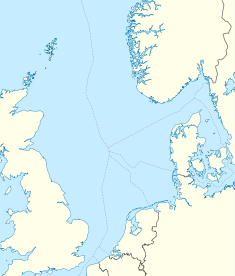Oseberg oil field
| Oseberg | |
|---|---|
| Location of Oseberg | |
| Country | Norway |
| Offshore/onshore | Offshore |
| Coordinates | 60°29′30.7104″N 2°49′38.3304″E / 60.491864000°N 2.827314000°ECoordinates: 60°29′30.7104″N 2°49′38.3304″E / 60.491864000°N 2.827314000°E |
| Operators | Statoil |
| Field history | |
| Discovery | 1979 |
| Start of production | 1988 |
| Production | |
| Current production of oil | 14,121 m3/d (88,820 bbl/d) |
| Producing formations | Upper Triassic to Lower Jurassic Statfjord formation; Middle Jurassic, Oseberg, Rannoch, Etive, Ness and Tarbert formations |
Oseberg (Norwegian: Osebergfeltet) is an offshore oil field with a gas cap in the North Sea located 140 km (87 mi) northwest of the city of Bergen on the southwestern coast of Norway. The field, which is 25 km long by 7 km wide, was discovered in 1979 and its development is known to be one of the significant milestones in emergence of Norway's independent oil and gas industry. The Oseberg field was named after Oseberg ship, one of Norway's most significant archeological discoveries. The ancient Viking ship from the early 9th century was discovered in a 1904 historical excavation of a burial mound at the Oseberg Farm, south of Oslo.
An extensive subsea pipeline network called Oseberg Transport System (OTS) transports up to 765,000 bbl/d (121,600 m3/d) from the Oseberg area to Sture terminal in Norway. The sea depth in the Oseberg area is 100 meters. The Oseberg Field Centre consists of three platforms: Oseberg A, B and D, connected to each other by bridges, in the southern part of the Oseberg field and the Oseberg C platform, which is located 14 kilometers north of the field center. The operator is Statoil, in partnership with Petoro, Total, ExxonMobil and ConocoPhillips. The field extends into blocks 30/6 and 30/9, parts of Production licenses (PL) 053 and 079.
The first exploration well on the PL053 license, 30/6-1, was drilled as a wildcat and spudded on 19 June 1979. The well was plugged and abandoned as a gas discovery on 22 September. Subsequent appraisal wells proved oil in addition to the gas found by the discovery well and Oseberg was produced as an oilfield. The first exploration well on the PL079 license, 30/9-1 was drilled as a wildcat at the end of 1982, but treated as an appraisal after it encountered oil and gas considered to form part of the same accumulation. In 2006, well 30/9-B-19 A proved reserves in the underlying Upper Triassic to Lower Jurassic Statfjord formation. Tests are also being carried out on the overlying Upper Cretaceous Chalk Group reservoir to evaluate the flow characteristics.
...
Wikipedia

